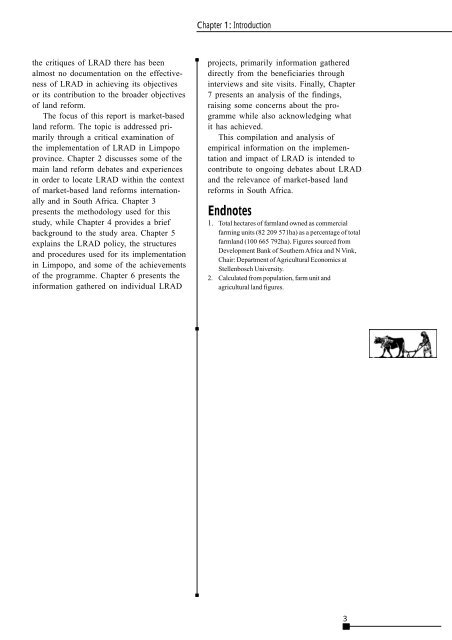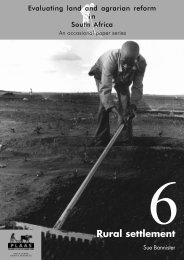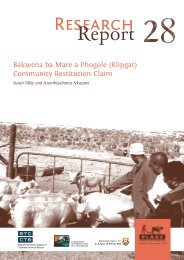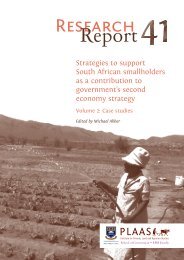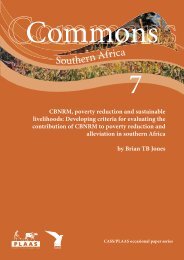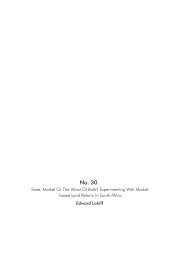A critical appraisal of South Africa's market-based land reform policy
A critical appraisal of South Africa's market-based land reform policy
A critical appraisal of South Africa's market-based land reform policy
Create successful ePaper yourself
Turn your PDF publications into a flip-book with our unique Google optimized e-Paper software.
Chapter 1: Introduction<br />
the critiques <strong>of</strong> LRAD there has been<br />
almost no documentation on the effectiveness<br />
<strong>of</strong> LRAD in achieving its objectives<br />
or its contribution to the broader objectives<br />
<strong>of</strong> <strong>land</strong> <strong>reform</strong>.<br />
The focus <strong>of</strong> this report is <strong>market</strong>-<strong>based</strong><br />
<strong>land</strong> <strong>reform</strong>. The topic is addressed primarily<br />
through a <strong>critical</strong> examination <strong>of</strong><br />
the implementation <strong>of</strong> LRAD in Limpopo<br />
province. Chapter 2 discusses some <strong>of</strong> the<br />
main <strong>land</strong> <strong>reform</strong> debates and experiences<br />
in order to locate LRAD within the context<br />
<strong>of</strong> <strong>market</strong>-<strong>based</strong> <strong>land</strong> <strong>reform</strong>s internationally<br />
and in <strong>South</strong> Africa. Chapter 3<br />
presents the methodology used for this<br />
study, while Chapter 4 provides a brief<br />
background to the study area. Chapter 5<br />
explains the LRAD <strong>policy</strong>, the structures<br />
and procedures used for its implementation<br />
in Limpopo, and some <strong>of</strong> the achievements<br />
<strong>of</strong> the programme. Chapter 6 presents the<br />
information gathered on individual LRAD<br />
projects, primarily information gathered<br />
directly from the beneficiaries through<br />
interviews and site visits. Finally, Chapter<br />
7 presents an analysis <strong>of</strong> the findings,<br />
raising some concerns about the programme<br />
while also acknowledging what<br />
it has achieved.<br />
This compilation and analysis <strong>of</strong><br />
empirical information on the implementation<br />
and impact <strong>of</strong> LRAD is intended to<br />
contribute to ongoing debates about LRAD<br />
and the relevance <strong>of</strong> <strong>market</strong>-<strong>based</strong> <strong>land</strong><br />
<strong>reform</strong>s in <strong>South</strong> Africa.<br />
Endnotes<br />
1. Total hectares <strong>of</strong> farm<strong>land</strong> owned as commercial<br />
farming units (82 209 571ha) as a percentage <strong>of</strong> total<br />
farm<strong>land</strong> (100 665 792ha). Figures sourced from<br />
Development Bank <strong>of</strong> <strong>South</strong>ern Africa and N Vink,<br />
Chair: Department <strong>of</strong> Agricultural Economics at<br />
Stellenbosch University.<br />
2. Calculated from population, farm unit and<br />
agricultural <strong>land</strong> figures.<br />
3


